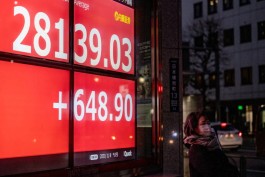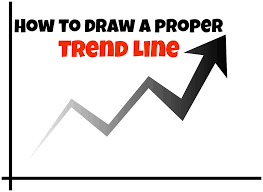Trend lines
The basic trend line is one of the simplest of the technical tools employed by the chartist, but by any standard the most powerful and valuable tool in trading. The trend line is constructed when there are three higher or lower points to be connected. This forms a channel which the price action can be monitored.
As discussed, one of the obvious presumptions derived from chart studies is that prices have a prevailing tendency to move in a particular direction. This trend frequently assumes a definition pattern which evolves along a straight line. This ability of prices to adhere extremely close to an imaginary straight line is one of the most extraordinary characteristics of chart movements.
Drawing a Trend line
The correct drawing of trend lines is an art like every other aspect of charting and some experimenting with different lines is usually necessary to find the right one. Sometimes a trend line which appears to be correct may have to be redrawn. With practice, the art of drawing trend lines becomes easier, but initially there are some useful guidelines in the search for the correct one.
There must be evidence of a trend. This means that, for an up trend line to be drawn there must be at least two reaction lows with the second low higher than the first. Once two ascending lows have been identified, a straight line is drawn connecting the lows and projected up and to the right.
Once the third point has been confirmed and the trend proceeds in its original direction, the trend line becomes very useful in a variety of ways. One of the basic concepts of technical analysis is that a trend in motion will tend to stay in motion. Therefore, once a trend assumes a particular slope or a rate of speed, as identified by the trend line, then it usually maintains the same slope. The trend line then helps not only to determine the extremities of the corrective phases but also importantly, when that trend is changing. Very often the breaking of the trend line is one of the best early warnings of a change in trend.
The Significance of the Trend line
It is very important to discuss how to determine the significance of a trend line. In every market and on every chart you see there are many trends in motions, short term, mid term, long terms, hourly and so on. However, not all these trends will be significantly strong. If they are not, a trader runs the risk of entering or exiting the market at the wrong time. The more significant a trend line, the more confidence it inspires and the more important its penetration.
There are two factors that determine the significance of a trend line. Firstly, the length of time it has been intact, and secondly how many times it has been tested. A trend line that the market has tested 8 times for example, but keeps pushing the price away, is obviously a more significant trend line than one that has only been tested twice. As a rough estimate after the third bounce off the trend line will be when the market will start to offer trading signals. Similarly, a trend line that has been intact for the last 9 months is of more importance than one that has been intact for 9 weeks. There is no standard as to what duration one needs to wait before relying on the trend, as some trends will only stay in motion for short periods of time. To catch these, you have to use the time in conjunction with the testing of the line.
Upward trend An up trend line is a straight line drawn up to the right of the chart along successive higher highs and lows.

Downward trend A down trend line is a straight line drawn down to the left of the chart along successive lower highs and lows.

Range trading The prices move up and down in a horizontal trading channel for an extended period of time.







































